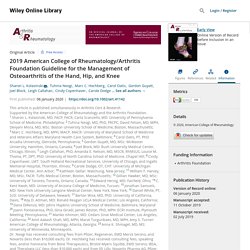

Diet in Rheumatoid Arthritis versus Systemic Lupus Erythematosus: Any Differences? As mentioned above, diet may have a beneficial role in patients with RMDs such as SLE due not only to a direct action of nutrients on the immune system and inflammation but also to an indirect effect on insulin resistance, obesity and associated co-morbidities [9,10].
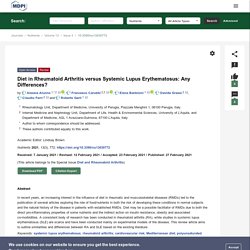
However, the existing controversy on diet as a preventive measure for SLE also exists with regard to the role of nutrients as modulators of SLE pathogenesis in patients with overt disease (Table 2). While several studies have been published in experimental SLE, few are available in humans. Furthermore, one main pitfall in investigating diet manipulation not only in SLE but also in other RMDs and chronic diseases is the objective difficulty of setting up an appropriate control group in studies assessing restrictive diets.
Therefore, not only are studies scarce but the few available data have a low level of evidence. 3.1. 3.2. Nutrition and Rheumatoid Arthritis in the ‘Omics’ Era. It is already well documented from epidemiological studies that nutritional patterns could play a role both as disease risk and protective factor, on the basis of the properties of particular foods.
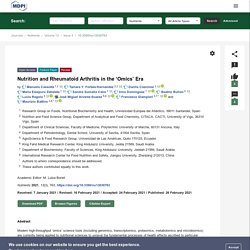
Certain nutritional factors can indeed exhibit pro-inflammatory outcomes (for e.g., red meat, salt, excessive caloric intake) or conversely mitigate inflammation (for e.g., fruit and vegetables, flaxseeds, low caloric intake) [5,6]. Nutritional components derived from diet, such as glucids, amino acids, fatty acids, vitamins, minerals, and other natural compounds occurring in small quantities in food, can not only fulfil a structural role in the cell, but also represent molecular signals which may impact biochemical pathways and alter gene expression. It is already well documented from epidemiological studies that nutritional patterns could play a role both as disease risk and protective factor, on the basis of the properties of particular foods. Relationship between the Gut Microbiome and Osteoarthritis Pain: Review of the Literature. Osteoarthritis (OA) is the most common form of chronic pain in Europe (34%), representing a great economic and social cost to society [1].
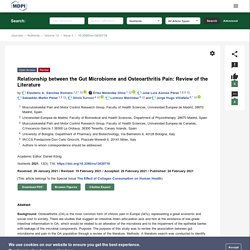
Likewise, there is a directly proportional relationship of suffering greater pain intensity with medical comorbidities, obesity, lower educational level, depression, belonging to a younger generation and joint degeneration [2]. However, in recent years, OA has been more closely related to central sensitization (CS) mechanisms [3,4,5]. This sensitization in spinal cord and brain shows in experimental studies how patients with OA are more sensitive to experimental noxious stimuli at body sites away from their affected joints compared to patients without OA pain [6]. One possible mechanism that relates to CS is widespread inflammation [7]. On the other hand, the severity of the joint disease is not related to the pain experienced [8].
It is well-known that our lifestyle greatly influences the prevalence of OA. Osteoarthritis: care and management. This guideline covers assessing and managing osteoarthritis in adults.

It covers both pharmacological and non-pharmacological treatments. It promotes effective treatment options to control joint pain and improve function in people with osteoarthritis. Diet as a Modulator of Intestinal Microbiota in Rheumatoid Arthritis. The beneficial effects of the MD in health and disease have been widely reported, but only a small number of trials have focused on RA [98].
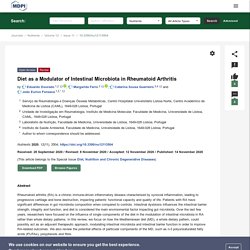
Although research in the field of diet–health relationships is changing its paradigm, and the study of whole dietary patterns is becoming more pertinent [130], more relevance has been given to the impact of specific components in RA-related outcomes [98]. The relationship between dietary patterns and rheumatoid arthritis: a case–control study. 1.Stavropoulos-Kalinoglou A, Metsios G, Smith J, Panoulas V, Douglas K, Jamurtas A, et al.
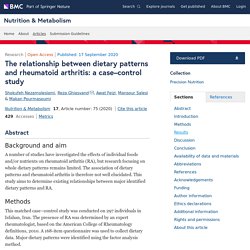
What predicts obesity in patients with rheumatoid arthritis? An investigation of the interactions between lifestyle and inflammation. Int J Obes. 2010;34(2):295.CAS Article Google Scholar 2.Tedeschi SK, Bathon JM, Giles JT, Lin TC, Yoshida K, Solomon DH. Relationship between fish consumption and disease activity in rheumatoid arthritis.
Do Interventions with Diet or Dietary Supplements Reduce the Disease Activity Score in Rheumatoid Arthritis? A Systematic Review of Randomized Controlled Trials. The aim was to compile the evidence from Randomized Controlled Trials (RCTs) of diet or dietary supplements used to reduce disease activity in adults with Rheumatoid Arthritis (RA).
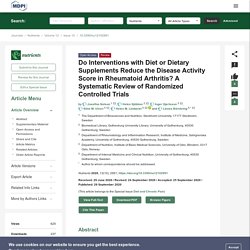
Ideal food pyramid for patients with rheumatoid arthritis: A narrative review - Clinical Nutrition. Benefits of Probiotics in Rheumatic Diseases. Rheumatic diseases are chronic conditions which affect a large proportion of the population worldwide (1).
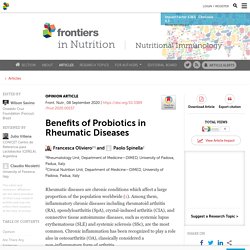
Among them, inflammatory chronic diseases including rheumatoid arthritis (RA), spondyloarthritis (SpA), crystal-induced arthritis (CIA), and connective tissue autoimmune diseases, such as systemic lupus erythematosus (SLE) and systemic sclerosis (SSc), are the most common. Chronic inflammation has been recognized to play a role also in osteoarthritis (OA), classically considered a non-inflammatory form of arthritis. Although different risk factors influence their onset and development, these heterogeneous conditions share common clinical outcome including joint pain, disability, and comorbidities (2). Over the last years increasing attention have been paid to the role of diet in the pathogenesis and progression of rheumatic diseases.
The most commonly used are Lactobacilli (L.), Bifidobacteria (B.), and Streptococci (S.), either as single species or in mixed culture. Table 1. 1. 2. Anti-inflammatory Diet In Rheumatoid Arthritis (ADIRA)—a randomized, controlled crossover trial indicating effects on disease activity. We use cookies to enhance your experience on our website.
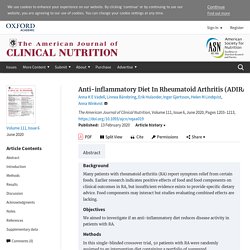
By clicking 'continue' or by continuing to use our website, you are agreeing to our use of cookies. You can change your cookie settings at any time. We use cookies to enhance your experience on our website.By continuing to use our website, you are agreeing to our use of cookies. You can change your cookie settings at any time. <a href=" Find out more</a> Skip to Main Content Search Close Advanced Search Search Menu Article Navigation Volume 111. 2019 American College of Rheumatology/Arthritis Foundation Guideline for the Management of Osteoarthritis of the Hand, Hip, and Knee - Kolasinski - - Arthritis & Rheumatology. Methods This guideline, from the American College of Rheumatology (ACR) and the Arthritis Foundation (AF), follows the ACR guideline development process (https;://www.rheum;atolo;gy.org/Pract;ice-Quali;ty/Clini;cal-Suppo;rt/Clini;cal-Pract;ice-Guide;lines;), using the Grading of Recommendations Assessment, Development and Evaluation (GRADE) methodology to rate the quality of the available evidence and to develop the recommendations 6.
